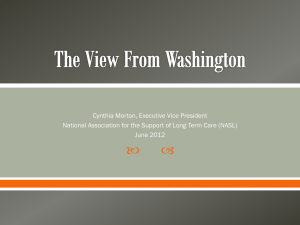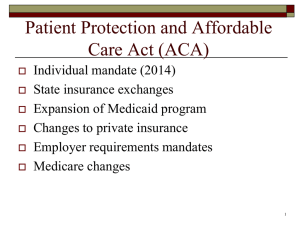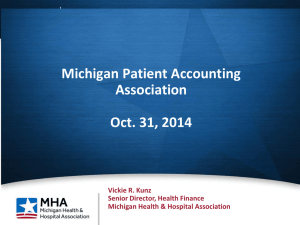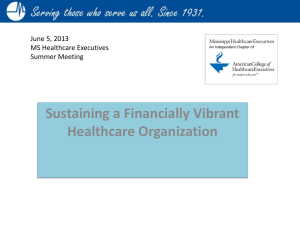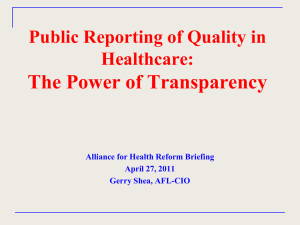MEDICARE WAGE INDEX
advertisement
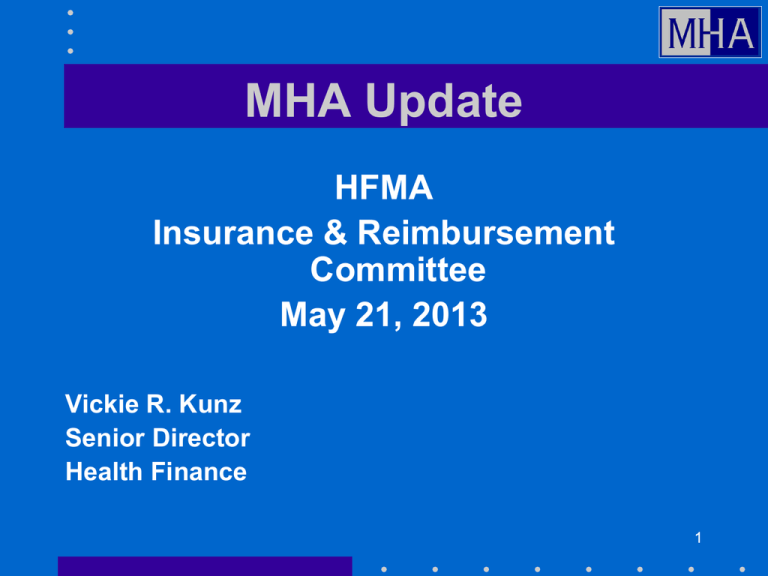
MHA Update HFMA Insurance & Reimbursement Committee May 21, 2013 Vickie R. Kunz Senior Director Health Finance 1 Who is the MHA? • Advocacy organization representing all hospitals in Michigan. • Services include: – State advocacy on proposed legislation, including Medicaid funding and policy activities – Federal advocacy and policy on Medicare and Medicaid issues – MHA Keystone Center – Quality Improvement Initiatives – BCBSM Contract Administration Process • Unique to Michigan 2 Payer Issues • Hospitals are reminded that a role of the MHA is to assist in resolving systematic payer issues. • Hospital contracts determine many terms and conditions and take precedence. • Communicate issues to Marilyn LitkaKlein or Vickie Kunz at the MHA. 3 Medicare • • • • IPPS & LTCH Proposed Rules IRF Proposed Rule SNF Proposed Rule Medicare Advantage 4 IPPS Proposed Rule Overview • Rate update = +0.5 percent • Limited coding adjustments • Medicare DSH policy changes • Inpatient admission guidance • VBP Program: FY 2016-2019 program proposals • Readmissions Reduction Program: FY 2014 and 2015 proposals • HAC Reduction Program: FY 2015 proposals • IQR Program updates voluntary EHR-based reporting • Expiration of low-volume adjustment criteria and MDH program 5 IPPS Proposed Rule • For hospitals that comply with IQR requirements, overall rate change after budget neutrality is a net 0.5 percent increase comprised of: ↑ Plus 2.5 percent marketbasket increase ↓Minus 0.4 percentage point productivity adjustment ↓Minus 0.3 percentage point ACA-mandated adjustment ↓Minus 0.8 percent ATRA-mandated coding adjustment ↓Minus 0.2 percent offset for - IP admission guidance ↓Minus 0.3 percent budget neutrality adjustment This excludes the impact of the 2 percent sequester. 6 Retrospective Coding Adjustment • The American Taxpayer Relief Act (ATRA) included a coding reduction of $11 billion (or 9.3%) over four-years. • This authority allows CMS to retroactively recoup for increases in IP payments that the agency believes occurred during FY 2008 – 2013 solely due to hospital coding improvements. 7 Cont., Coding Adjustment • For FY 2014, the CMS proposes to phase-in the implementation with a 0.8 percent reduction. The adjustment will need to increase in the subsequent three years in order for the CMS to recoup the mandated amount. ATRA analysis distributed to hospitals Jan. 10 indicates a cut of nearly $437 million to Michigan IPPS payments during FY 2014 – 2017. 8 Payment Rate Update Federal Operating and Hospital-Specific Rates Federal Capital Rate Marketbasket (MB) Update/Capital Input Price Index +2.5% +0.9% ACA-Mandated Productivity MB Reduction -0.4% — ACA-Mandated Pre-Determined MB Reduction -0.3% — American Taxpayer Relief Act (ATRA)-Mandated Retrospective Coding Adjustment Reduction -0.8% — Inpatient Admission Guidance Offset -0.2% -0.2% Net Rate Change (EXCLUDING BUDGET NEUTRALITY) +0.8% +0.7% 9 Standardized Operating Amounts For Hospitals with an Area Wage Index Greater Than 1.0 (69.6 Percent Labor Share / 30.4 Percent Non-Labor Share) Full Update LaborRelated NonlaborRelated Reduced Update LaborRelated $3,741.72 $1,634.32 $3,668.21 NonlaborRelated $1,602.21 10 Standardized Operating Amounts, cont’d. For Hospitals with an Area Wage Index Less Than or Equal to 1.0 (62.0 Percent Labor Share / 38.0 Percent Non-Labor Share) Full Update LaborRelated NonlaborRelated Reduced Update LaborRelated NonlaborRelated $3,333.14 $2,042.90 $3,267.66 $2,002.76 11 Capital Payment Update • Proposed federal capital rate of $432.03, up from the current $425.49. – a 1.5 percent increase. 12 MS-DRGs • No major changes made for FY 2014. • CMS proposes to maintain the current 751 MS-DRGs. • 85% of MS-DRGs will have weight change of +/- 6%. • See Table 5 in final rule for Excel file containing relative weights. 13 Cont., MS-DRGs • See May 6 Monday Report article which includes a link to an Excel file which compares current to proposed relative weights. • Also see MHA Advisory Bulletin # 1344 in May 6 Weekly Mailing. • Hospitals can use their inpatient claims analysis distributed November 2012 to estimate impact of updated MS-DRG weights. 14 Impact on Top MS-DRGs MS-DRG Medicare Discharges Description % Change 470 16,847 Major Joint Replace/Reattachment Lower Extremities w/o CC/MCC ↑2.7% 871 15,548 Septicemia w/o MV96+ hours with MCC ↓ 1.3% 392 10,047 Esophagitis, Gastro & Misc Digest Disorder w/o MCC ↓ 0.5% 292 9,124 Heart failure & shock with CC ↓ 0.8% 291 8,989 Heart failure & shock with MCC ↓ 0.7% 15 Cost Outlier Threshold • Final 2013 threshold: • Proposed 2014 threshold: $21, 821 $24,140 • Represents a 10.6% increase in the cost outlier threshold, resulting in fewer cases being eligible for outlier payments. • Threshold is adjusted annually based on CMS’ projections for total outlier payments to ensure that total outliers payments equal 5.1 percent of total IPPS payments. 16 DSH & IME Payments • CMS proposes to include days for labor & delivery services in the Medicare GME payment adjustment calculations for cost reporting periods beginning on/after Oct. 1, 2013. – This policy would reduce GME payments to hospitals and may impact the eligibility of hospitals seeking SCH status. • CMS recently adopted this policy change for the Medicare DSH purposes. 17 Cont. DSH Changes • CMS proposes to readopt its policy of counting the days of patients enrolled in MA plans in the Medicare fraction of the traditional DPP percentage. • CMS is appealing a recent court ruling that disallowed the inclusion of these days. 18 Medicaid SSI Category • MSA recently announced that data is now available for hospitals to validate their SSI ratio data provided by CMS and used for Medicare DSH payment calculations. • Hospitals often find Medicaid patient days that are not included in CMS file for individuals approved for Michigan Medicaid in SSI category. • Potential to increase Medicare DSH payments. • See MHA Advisory Bulletin #1343 from May 6 WM. 19 FTEs at CAHs • For purposes of IME and GME payments, a hospital may not claim FTE resident training that occurred at a CAH. • However, if the CAH itself incurs the costs of training, then the CAH may receive 101% of the reasonable cost incurred for resident training. 20 Expiring IPPS Provisions • These provisions were extended by the ATRA. Absent subsequent federal legislation, these expire Sept. 30, 2012: – Low volume adjustment • Estimated $10.7 M increase to Michigan IPPS payments in FY 2013. – Medicare Dependent Hospital Status • Estimated $1.2 M increase to FY 2013 payments. 21 Wage Index • No major changes for calculating the wage indexes, rural floor budget neutrality or administrative reclassification rules. • FY 2014 index based on hospital data from CRs ending during FY 2011 and occupational mix data from the calendar 2010 survey. • National FY 2014 occupational-mix adjusted average hourly wage: $38.3620. • See link to Michigan AWI values in A/B #1344. 22 Labor Related Share • Hospitals with an AWI > than 1.0: – Slight increase from 68% to 69.6% • Will result in a positive impact on hospitals • Hospitals with AWI < or =1.0: ‒ By law, remains at 62%. 23 CBSA Definitions • CMS does not propose to make any changes to the current CBSA definitions based on the 2010 census but indicates that it will likely do so for FY 2015. 24 Occupational Mix Survey • CMS required to collect data every three years on the occupational mix of employees for PPS hospitals participating in Medicare. • 2010 survey data used for FY 2014. • Hospitals completed and submitted the revised survey by July 1, 2011. 25 Wage Index Timeline • May 3 – CMS release of updated PUFs • May 8 – MHA distribution of hospital-specific wage and occupational mix worksheets that compare data from May CMS file to that from February file. • June 3 – Deadline for hospitals to submit correction requests to both CMS and their FI/MAC. • Oct. 1, 2013 – Effective date of FY 2014 AWI • Early Oct. 2013 – Release of PUF for FY 2015 AWI • Mid-to-Late Oct. 2013 – MHA Wage Index Workshop (webinar) • FY 2015 AWI will use data from cost report FYEs: – Oct. 2011 – Sept. 2012 26 Overview: ACA DSH Changes Medicare Current DSH $ ($11 B) 25% Paid Under Traditional Method 75% Dedicated to New Pool Step 1: Reduce Pool [relative to insurance pick up rates] Step 2: Distribute Pool [base on uncompensated care] 27 Medicare DSH Proposals: Reductions • By the numbers: – Estimated total DSH funding for FY 2014 = $12.3 B – Estimated 25% rate-based and paid under traditional formula = $3.1 B – Estimated 75% for uncompensated care payments = 9.3 B • Proposal for reducing funding dedicated to uncompensated care payment: – Use CBO’s March 2010 and February 2013 insurance rate estimates • FY 2013 = 18% uninsured • FY 2014 = 16% uninsured – Result = 11.2% reduction; amount for uncompensated care payment = $8.2 B (about $1.0 B cut) • [(16% / 18% - 1) = 11.1% plus legislated 0.1 percentage point = 11.2%] 28 Medicare DSH Proposals Redistributions • Proposal for distributing funding dedicated to uncompensated care payment: – Use low-income patient days as proxy • Medicaid days and Medicare SSI days • numerators of current DSH % calculation – CMS may use cost report worksheet S-10 in future years • Cites unreliable data as decision to use proxy – Calculate uncompensated care payment factor • Hospital's low-income patient days relative to all DSH hospital low-income patient days 29 Cont., DSH Changes • Projected changes would reduce Medicare DSH payments to Michigan hospitals by $57m. • $31 million due to total $1 billion cut • $26 million cut due to methodology change • Pending legislation to delay for 2 years. 30 Medicare Proposed Changes to Inpatient Status • Proposal for patient to spend two midnights in hospital – RAC would “presume” these are ok • Anything less than 2 two midnights would be outpatient, unless documentation in medical record supports need for inpatient care – These have been most of RAC denials nationally • CMS impact is $220 million increase, the 0.2% reduction included in inpatient operating rate. 31 Readmissions Reduction Program • Established by the ACA and designed to reduce Medicare inpatient payments for acute care hospitals with higher than expected riskadjusted readmission rates related to certain conditions. – CAHs are excluded. • Began Oct. 1, 2012 (FY 2013) • Medicare payment reduction increasing from 1 percent to 2 percent in FY 2014 and then increasing to 3 percent in FY 2015. 32 Cont., Readmissions Reduction • Uses 3 years of data from an updated 3-year period to calculate readmission rates. – July 1, 2009 – June 30, 2012 • Defines a readmission as a hospital admission within 30 days from the date of discharge from the index hospital (the initial hospitalization hospital) • Hospitals either maintain full payment levels or be subject to payment penalty of up to 2% in FY 2014 for all IPPS discharges if readmission rate higher than national average for 3 medical conditions. 33 Cont., Readmissions Policy • CMS proposes to modify the calculation of readmission rates to better account for planned readmissions. – Expected to reduce current national AMI readmissions rate by 1 percentage point. – Expected to reduce heart failure readmissions rate by 1.5 percentage points. – Expected to reduce pneumonia readmissions rate by 0.7 percentage points. 34 Cont., Readmissions Reduction • CMS is using the following measures, currently included in the hospital IQR program and collected from Medicare FFS claims data, for use in FY 2014: – Acute Myocardial Infarction – Heart Failure – Pneumonia 35 Cont., Readmissions • Starting with FY 2015, CMS has the authority to expand the policy to additional conditions. • Proposes to add two 30-day readmissions measures to the program. – COPD – Total hip and knee arthroplasties 36 Cont., Readmissions • Unlike VBP, readmissions reduction program is not budget-neutral. – Nationally, is expected to cut IPPS payments by $175 million in FY 2014, down from $300 million in FY 2013. – FY 2013 policy was expected to reduce Michigan IPPS payments by approximately $14 million. 37 • Value Based Purchasing - What’s at Stake Under VBP? • Program is self-funded by hospital “contribution” Contribution based on Medicare FFS payment* – 1.0% reduction in FY 2013 – FY 2014 Reduction increases to 1.25% – 2.0% reduction for FY 2017 and beyond VBP performance determines P4P amount Budget-neutral – Redistributive – Best performers win, others break even or lose – VBP payments are netted against contributions * Payment reductions exclude IME, DSH low-volume hospitals and outliers. 38 Medicare VBP Evolution 39 HAC Reduction Program Overview • ACA-mandated – must start in FY 2015 • First program policies outlined in 2014 rule • 1% reduction in IPPS payments for hospitals with highest HAC “scores” – Would penalize 25% of hospitals nationally • For determining FY 2015 penalties, CMS proposes to use up to 8 quality measures grouped into 2 domains. 40 IPPS Proposed Rule Impact • Hospital-specific DSH analysis to be distributed week of May 20. • Hospital-specific overall impact analysis to be distributed via email to CEOs, CFOs and RDs shortly after. • Including detailed summary of proposed rule. • Distribution to include Directors of Patient Safety & Quality Improvement. • Impact report reflects readmissions and VBP factors. – VBP factors not final at this time as the CMS continues to review the data. 41 IPPS PROPOSED RULE SUMMARY System Component Change Update Factor (net of all rate adjustments) 0.5% Wage Index No major policy changes; may redefine CBSAs for FY 2015 based on 2010 census. VBP -1.25% with chance to earn back some, all, or more of program contribution and new rules for 2015 and 2016 programs Readmissions Remain whole or subject to up to - 2.0% (up to -3% for FY 2015) GME/DSH Technical changes/clarifications for counting beds, timely filing, and ACA provisions for redistributing unused/closed hospital FTE slots Low-Volume Adjustment ATRA extension expires, program reverts to more restrictive rules MDH/SCH Special Rural Status ATRA extension of MDH program expires; SCH status could be terminated retroactively in certain circumstances IQR Program 55 Measures maintained for FY 2014; 72 to 59 for FFY 2015 determinations. 60 for FFY 2016. HACs removed from IQR Outlier Payments 10.6% threshold increase from $21,821 to $24,140. HAC DRG Payment Policy 2 new categories; 2 new diagnoses for current category. 42 2% Sequestration Cut • ATRA delayed to March 1. • 2% cut was applied to Medicare FFS payments beginning for dates of service on/after April 1. – effective 2013 – 2021 – mandated by the Budget Control Act of 2011. • Michigan annual impact projected at $144M. – IPPS payments reduced $95 million – OPPS payments reduced $34 million • May apply to MA payments depending upon hospital contractual agreement with MA plans. 43 Outpatient Therapy Services • 2013 collection of claims-based data on patient functional status over an episode of PT, OT and SLP services. • All therapists will be required to report new G-codes and modifiers on the claim form: – initial evaluation, every 10 visits and at discharge. – testing period thru June 30, after that date, claims will reject. 44 LTCH Proposed Rule • Base rate $40,622.06 for those that submit quality data; $39,823.99 for those that don’t comply. • Includes a net 1.1 percent update • “25% Rule” - CMS is moving forward with full adoption of the 25% rule after a 5-year moratoria and additional one-year statutory relief. – Reduces payment to an IPPS-comparable amount for referrals from general acute hospitals that exceed a 25 percent threshold. 45 Cont., LTCH Proposed Rule • CMS adopted an LTCH-specific marketbasket value beginning with FY 2013. • Net 1.1% increase after: ↑ Plus 2.5 percent marketbasket increase ↓Minus 0.4 percentage point productivity adjustment ↓Minus 0.3 percentage point ACA-mandated adjustment ↓Minus 1.3 percent budget neutrality cut (second of three) ↑ Plus 0.6 percent for short-stay and high-cost outlier 46 Cont., LTCH Proposed Rule • CMS’s ongoing research on a potential approach to focus the LTCH setting on the treatment of “medically stable but high-acuity patients” known as “chronically critically ill” (CCI). • Encourages LTCHs to admit CCI patients and ensure that these frame the “core patient population”. 47 Cont., LTCH Proposed Rule • Full LTCH payment would be limited to patients who met CCI criteria upon discharge from acute hospital. • Non-CCI patients would be paid an IPPS-comparable amount. 48 LTCHQR Program • Beginning with FY 2014 payments, LTCHs must submit data on 3 quality measures being collected in FY 2012 or be subject to 2 percentage point penalty. • Proposal to add three new measures for the FY 2017 reporting program. 49 Inpatient Rehab Facilities Net 1.8% increase after: Plus 2.5 percent marketbasket update ↓Minus 0.4 percentage point productivity adjustment ↓Minus 0.3 percentage point ACAmandated adjustment 50 IRF 60 Percent Rule • Facility must demonstrate that at least 60% of its patients meet specific criteria including the need for intensive rehab services for 1 or more of 13 listed conditions. • For FY 2014, CMS proposes to remove a number of codes from the “presumptive compliance” list since without medical record documentation, thse codes do not prove compliance. 51 SNF Proposed Rule • Net 1.4% increase in per diem rates after: plus 2.3% MB update minus 0.5 percentage point forecast error adjustment. minus 0.4 percentage point multifactor productivity adjustment. 52 2013 OPPS Detailed Reports • Hospital-specific Excel files distributed March 27. • Top 50 APCs • Analysis of multi-level APCs • Small hospital reports distributed April 11. 53 Medicare Advantage Plans • As of April 2013, 34 plans in Michigan, with 485,000 or approximately 29% of Michigan’s 1.7 million Medicare beneficiaries enrolled. – Up to 20 plans in some counties. • Review MA payment rate for all plans. • CAH entitled to Medicare cost reimbursement. • Each MA plan may determine own utilization model and is not required to maintain electronic transactions. • Many MA have instituted “RAC-like” utilization programs. • Matrix of MA plans by county available at MHA website – updated quarterly, with MHA Monday Report article. – See April 29 Monday Report for latest info 54 Continued, MA Plans • Unlike Medicare FFS, each MA plan may determine its own utilization model and is not required to maintain uniform electronic payment processes with hospitals. • As Medicare enrollees continue to select MA plans, the variety of plans and payment processes may result in increased utilization scrutiny and administrative effort at hospitals. • MA plans may conduct their own RAC-like audits. 55 MA Plans & Sequestration • CMS payments to plans will be reduced for enrollment periods beginning on/after April 1, 2013. • Individual hospital contracts govern whether payments will be reduced. • In cases of non-contracted plans, plans have discretion whether to pass the 2% cut on to hospitals. • See May 13 Monday Report. 56 Medicare 10-Year Revenue Forecast • Distributed to CEOs/CFOs/Directors of Reimbursement and Government Relations Nov. 29. • Comprehensive analysis of Medicare revenue and payment reductions for 2013 – 2022, including: – Affordable Care Act-authorized changes – Budget Control changes (Sequestration) – American Taxpayer Relief Act (ATRA) 57 Medicaid Issues 58 Medicaid Payment Reform • Jan. 1, 2014 target implementation – MSA is considering a phase-in approach. • Four meetings to date. • Representatives include small, medium, and large hospitals and CAHs • Several ideas have been identified including: • statewide inpatient rate with hospital adjustors, • converting FFS capital to prospective system for fee-for-service, • Increase in outpt payments financed with reduced inpt rates • Recognition of hospital mission in payment adjustors. 59 Medicaid Expansion • ACA allows states to voluntarily expand Medicaid to uninsured adults. • Gov. Snyder proposes to expand Medicaid to cover individuals up to 138% of federal poverty level effective Jan. 1, 2014. • State legislature must appropriate the federal funds. 60 Cont., Medicaid Expansion • Expected to cover about 450,000 low-income adults who are currently uninsured but fail to meet current eligibility requirements. • Who would qualify? – Individuals that are at least 19 years old. – Those that are single, working with annual earnings up to $15,856 or in a family of four with earnings up to $32,499. 61 • Based on 138% of 2013 FPL MHA Expansion Resources • MHA supports expansion and urges member hospitals to use resources to educate legislators, members of the community, etc. – Saves Money, Saves Lives • Many tools available at: www.expandmedicaid.com. 62 Primary Care Physician Services • ACA provides certain physicians with Medicare rates for specific primary care services provided in 2013 and 2014. • Higher payments implemented for Medicaid FFS in early February. • Waiting for CMS approval for services paid through Medicaid HMOs. 63 Medicaid - Misc. • Implementation of pilot project to integrate care and payment for individual dually eligible for Medicare and Medicaid has been delayed, likely won’t begin until July 1, 2014 – Issue of payment rate remains unresolved • Regional implementation – 4 regions comprised: – 8 SW counties Macomb County – UP Wayne County 64 DSH Audits • Beginning with audits of FY 2011 DSH ceilings, hospitals subject to DSH payment recoveries if audits indicate DSH payments exceeded their actual DSH ceilings. • Prior year audit reports available on MSA’s website. 65 Continued, DSH Audits • FY 2009 DSH audit results indicate that 27 hospitals would have had payment recoveries totaling $111 million. • 2010 audits in process • DSH payment recoveries begin with FY 2011 DSH audit, expected to occur a year from now. 66 Proposed DSH Policy • MSA proposes multiple-step DSH process: – Initial DSH calculation – Interim DSH settlement – Final DSH audit-related redistribution 67 Initial DSH Calculation • MSA would calculate near the end of the state FY using data from hospital cost reports ending during the second previous state FY. • Hospitals would review MSA’s initial calculation. – Cost reports for FYEs 2010 will be used for 2012 initial calculations. – If hospital declines DSH during this step, the decision is irrevocable and the hospital is not eligible for any DSH for that FY. 68 Interim DSH Settlement • MSA would recalculate DSH ceilings, payments and Medicaid utilization rates using new cost report data. • MSA would recover and reallocate funds to other eligible hospitals for that specific pool. – During 2013, the MSA would use data from cost reports ending during calendar year 2012 to complete this step. 69 Final DSH Settlement • Final DSH audit would occur three years after state fiscal year. • Would recover and reallocate funds for public hospital DSH to remaining eligible hospitals for that pool then funds recovered from other DSH pools plus unspent funds recouped would be reallocated to eligible hospitals. 70 FY 2013 DSH Payments • Payments from $45 million regular DSH pool and $60 million tax-funded DSH pool to be distributed in September. • Payment amounts by hospital not yet available. • Hospitals are encouraged to request DSH ceiling info from MSA. 71 Medicaid Interim Payments • MSA released a proposed policy to change from bi-monthly to monthly MIP and CIP payments effective July 1, subject to CMS approval. 72 Medicaid RAC • MSA contract with Health Management Systems, Inc. (HMS) for both automated and complex reviews. • Can review Medicaid fee-for-service (FFS) claims up to 3 years after date of service. – Can currently review claims back to May 1, 2010. • May expand to Medicaid HMO claims in future. 73 Medicaid Provider Tax Bills • As a result of reporting changes for bad debts, MSA allowed hospitals to submit revised cost reports in December. ‒ Approx. 70 hospitals submitted • April tax bills incorporate revised tax base for the month and 1/3 of the retroactive adjustment back to Oct. 2012. • Q3 FFS tax bills will reflect revised tax base and retroactive adjustment 74 FY 2014 Hospital Tax Base • Hospitals are encouraged to review their FY 2012 filed cost reports and submit an amended report if needed. – FYEs Oct. 1, 2011 – Sept. 30, 2012 • Are bad debts reported as a reduction to net patient revenues or an operating expense? • See MHA Advisory Bulletin # 1340 included in March 11 Weekly Mailing. 75 FFS QAAP • FY 2013 Q3 MACI payments distributed May 9. • Corresponding tax bills distributed May 16, payments due June 10. • Q3 tax amounts were adjusted retro to Oct. 1, 2012. 76 2013 GME & HRA Payments • May GME Payments • May HRA Payments • May HRA Tax Due - May 20 June 3 June 17 • June GME Payments • June HRA Payments • June HRA Tax Due - June 24 July 8 July 22 77 FY 2013 Psych HRA Payments • Q3 payments • Q3 tax due date - July 5 July 19 • Q4 payments • Q4 tax due date - Oct. 3 Oct. 17 78 BCBSM • BCBSM Board approved changes to PHA to: – Include government shortfalls for traditional product only – Medicare and Medicaid fee-for-service • PHAAC hospital contingent urged BCBSM staff to consider method to include Medicare and Medicaid managed care in calculation 79 Hospital Charge Transparency • CMS recently released charge and average Medicare payment on the most common DRGs by hospital. • Michigan ranks 41st in the country in average Medicare billing by state. • Michigan’s gross charge per equivalent admission is 21% lower than the GL state average and 24% lower than the 80 US average. 0% -5% -6.0% -10% -15% -8.8% -9.7% -10.6% -10.7% -13.3% -14.7% -14.0% -16.5% -16.5% -17.7% -20% -17.8% -18.8% -19.4% -20.1% -19.2% -21.0% -21.0% -23.4% -25% -24.3% -30% 2002 2003 2004 2005 2006 GL 2007 2008 2009 2010 2011 US 81 Auto No Fault • HB 4612 would cap existing personal injury protection benefit at $1 million. • Create a new state-run insurance co. to relieve auto insurers of the cost of catastrophic injuries to policy holders. • Impose a new tax on auto ins policies. • Would trade significant catastrophic coverage for a one-time premium rebate 82 of $125. Cont., Auto No Fault • Reduction of reimbursement rate from controlled charges to fee screen or average of other payers. 83 AHA Survey Results • Annual MHA Advisory Bulletin that compares 2011 AHA Survey results for Michigan hospitals to those nationally. • Includes margins, ED visits, OP visits, IP admissions, days, births, ALOS, etc. • See MHA Advisory Bulletin # 1341, included in 03/18/13 weekly mailing. • Powerpoint and Excel files available. 84 8% 7.2% 6% 5.2% 4.9% 4.9% 5.5% 4.9% 4% 2.8% 2.4% 3.3% 3.4% 3.0% 1.8% 2.8% 2% 2.4% 1.9% 1.6% 1.7% 1.9% 0.8% 0% -0.3% -1.1% -2% -1.8% -1.5% -1.6% -2.6% -3.0% -4% 2002 -1.6% -2.8% -2.6% -3.2% 2003 2004 2005 Patient Margin 2006 2007 2008 Operating Margin 2009 2010 2011 Total Margin 85 MHA Resources • Monday Report is available FREE to anyone and is distributed via email each Monday morning. – Go to website and select “Newsroom”, then Monday Report • MHA Monday Report – electronic publication issued weekly • Request password if you don’t have one. – Email Donna Conklin at dconklin@mha.org to obtain MHA member ID number • Advisory Bulletins – Extensive communications available only to MHA members, as needed. (Require password to obtain from website). • Hospital specific mailings as needed for various impact analyses, etc. • Periodic member forums • See mha.org for other resources. • Monthly Financial Survey provides free benchmarking of financial and utilization statistics. 86 ???Questions??? Vickie Kunz, Senior Director, Health Finance Michigan Health & Hospital Association 110 West Michigan Avenue, Suite 1200 Lansing, MI 48933 Phone: (517) 703-8608 Fax: (517) 703-8637 email: vkunz@mha.org 87

